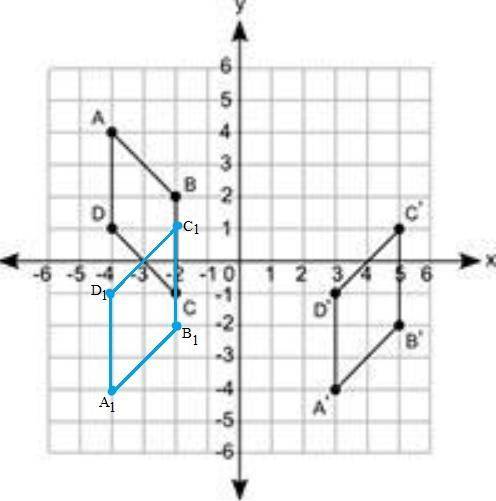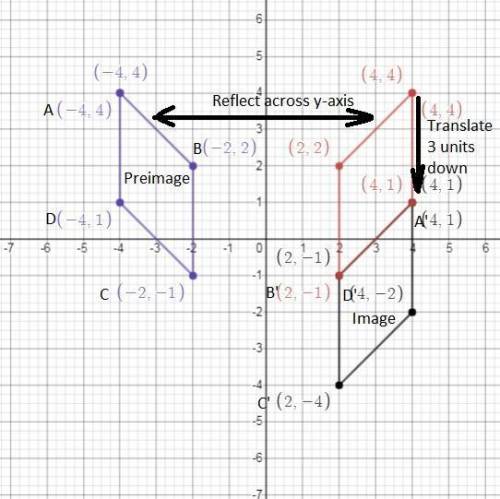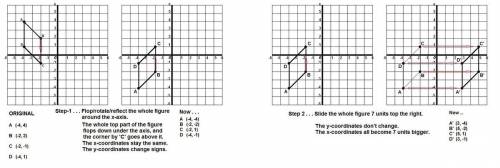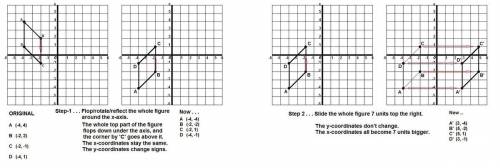 29
29 Part A: The graph reflected across y-axis and translated 4 units down.
Part B: Yes both figures are congruent.
Step-by-step explanation:
Part A:
From the given figure it is clear that the vertices of preimage are A(-4,4), B(-2,2), C(-2,-1) and D(-4,1).
The vertices of image are A'(4,0), B'(2,-2), C'(2,-5) and D'(4,-4).
The relation between preimage and image is defined by the rule

The graph reflected across y-axis, so

then translated 4 units down.

Therefore the graph of figure ABCD reflected across y-axis and translated 4 units down to get A'B'C'D'.
Part B:
Reflection and translation are rigid transformation. It means the size and shape of the image is same after reflection and translation.
Rigid transformation always produce congruent figures.
Since figure ABCD reflected across y-axis and translated 4 units down to get A'B'C'D', therefore

Yes both figures are congruent.
 10
10 Answer
:Reflected along x axis
Translated 7 units to the righ
A transformation of a point is the movement of the point from its initial position to a new position. If an object is transformed, all its points are also transformed. Types of transformation are reflection, rotation, dilation and translation.
Figure ABCD has A at (- 4, 4), B at (- 2, 2), C at (- 2, - 1), D at (- 4, 1).
If a point (x, y) is reflected along the x axis, its x coordinate remains the same and the y coordinate is opposite (negated). The new point is at (x, -y)
If a point (x, y) is translated h units to the right, the new coordinate is (x+h, y).The transformation are as follows:
It is reflected along the x axis so that the new coordinates would be at A1 at (- 4, -4), B1 at (- 2, -2), C1 at (- 2, 1), D1 at (- 4, -1)
It is translated 7 units to the right, The new coordinates are A' at (3, -4), B' at (5, -2), C' at (5, 1), D' at (3, -1)
Step-by-step explanation:
Hopefully this helped, if not HMU and I will get you a better answer! :)
Can i get brainliest plz, im trying to unpgrade my rank!
Given:
Vertices of ABCD are A(-4,4), (-2,2), C(-2,-1) and D(-4,1).
Vertices of A'B'C'D' are A'(3,-4), B'(5,-2), C'(5,1) and D'(3,-1).
To find:
The sequence of transformations that changes figure ABCD to figure A'B'C'D'.
Solution:
Part A:
The figure ABCD reflected across the x-axis, then

Using this rule, we get

Similarly, the other points are  .
.
Then figure translated 7 units right to get A'B'C'D'.


Similarly, the other points are  .
.
Therefore, the figure ABCD reflected across the x-axis and then translated 7 units right to get A'B'C'D'.
Part B:
Reflection and translation are rigid transformation, it means shape and size of figures remains same after reflection and translation.
Therefore, the two figures congruent.

Part A: The graph of ABCD is reflected across y-axis and translate 3 units down.
Part B: The figures ABCD and A'B'C'D' are congruent.
Step-by-step explanation:
Part A:
From the given graph it is clear that the coordinates of ABCD are A(-4,4), B(-2,2), C(-2,-1) and D(-4,1).
The vertices of A'B'C'D' are A'(4,1), B'(2,-1), C'(2,-4) and D'(4,-2).
If the graph of ABCD is reflected across y-axis, then

Using this rule the vertices of ABCD after reflection across y-axis are A₁(4,4), B₁(2,2), C₁(2,-1) and D₁(4,1).
If the graph of A₁B₁C₁D₁ is translate 3 units down, then

The vertices of ABCD after reflection across y-axis and translation 3 units down.




Therefore the graph of ABCD is reflected across y-axis and translate 3 units down.
Part B:
Reflection and translation is a rigid transformation. It means the size and shape of figure remains same.
Therefore the figures ABCD and A'B'C'D' are congruent.

Step-by-step explanation:
To go from ABCD to A’B’C’D’ takes two transformations.
Step-1 : Reflect the original figure around the x-axis.
Step-2 : Slide the new figure 7 units to the right.
See the attached drawing. It shows the whole process
including the intermediate status and coordinates of
the four points after Step-1. You’ll love it.
B). I looked up a definition of ’congruent’. It said that two figures
are congruent if they have have the same shape and size after
being moved, rotated, or reflected. (I was worried about the
’reflected’ part. )
With that definition, I’ll let you decide whether these figures
are congruent.
In conclusion, let me express my gratitude for the generous
5-points bounty with which I’ve been showered by answering
this question. The green crust and the cup of tepid turgid water
have been delicious, and by working quickly and efficiently, I was
able to construct the attached file in less than an hour.


Step-by-step explanation:
To go from ABCD to A’B’C’D’ takes two transformations.
Step-1 : Reflect the original figure around the x-axis.
Step-2 : Slide the new figure 7 units to the right.
See the attached drawing. It shows the whole process
including the intermediate status and coordinates of
the four points after Step-1. You’ll love it.
B). I looked up a definition of ’congruent’. It said that two figures
are congruent if they have have the same shape and size after
being moved, rotated, or reflected. (I was worried about the
’reflected’ part. )
With that definition, I’ll let you decide whether these figures
are congruent.
In conclusion, let me express my gratitude for the generous
5-points bounty with which I’ve been showered by answering
this question. The green crust and the cup of tepid turgid water
have been delicious, and by working quickly and efficiently, I was
able to construct the attached file in less than an hour.


 2
2 down 3, left 1.
reflection over y-axis
yes, the 2 figures are congruent
Step-by-step explanation:
 10
10  4
4 
It will provide an instant answer!
